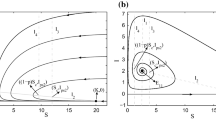Abstract
A pest management SI model with impulsive releases of infective pests and spraying pesticides is proposed and investigated. We prove that all solutions of the model are uniformly ultimately bounded. We also obtain the sufficient conditions of globally asymptotic stability periodic solution of pest-extinction and permanence of the model. The approach of combining impulsive releasing infective pests with impulsive spraying pesticides provides reliable tactical basis for the practical pest management.
Similar content being viewed by others
References
Falcon L A. Use of bacteria for microbial control of insects[M]. New York: Academic Press, 1971.
Burges H D, Hussey N W. Microbial control of insects and mites[M]. New York: Academic Press, 1971, 67–95.
Falcon L A. Problems associated with the use of arthropod viruses in pest control[J]. Annu Rev Entomol, 1976, 21:305–324.
Bailey N T J. The mathematical theory of infectious diseases and its applications[M]. London: Griffin, 1975, 413.
Burges H D, Hussey N W. Microbial control of insections and mites[M]. New York: Academic Press, 1971, 861.
Fenner F, Ratcliffe F N. Myxomatosis[M]. Cambridge: Cambridge University Press. 1965, 379.
Davis P E, Myers K, Hoy J B. Biological control among vertebrates[M]. In: Huffaker C B, Messenger P S (eds). Theory and Practice of Biological Control, New York: Plenum Press, 1976, 501–519.
Tanada Y. Epizootiology of insect diseases[M]. In: Debach P (ed). Biological Control of Insect Pests and Weeds, London: Chapman and Hall, 1964, 548–578.
Barclay H J. Models for pest control using predator release, habitat management and pesticide release in combineation[J]. J Appl Ecol, 1982, 19:337–348.
Paneyya J C. A mathematical model of periodically pulse chemotherapy: tumor recurrence and metastasis in a competition environment[J]. Bull Math Biol, 1996, 58:425–447.
D’Onofrio A. Stability properties of pulse vaccination strategy in SEIR epidemic model[J]. Math Biol, 2002, 179:57–72.
Van Lanteren J C. Integrated pest management in protected crops[M]. In: D Dent (ed). Integrated Pest Magangement, London: Chapman and Hall, 1995.
Roberts M G, Kao R R. The dynamics of an infectious disease in a population with birth pulse[J]. Math Biol, 2002, 149:23–36.
Xiao Y N, Chen L S. A ratio-depengent predator-prey model with disease in the prey[J]. Appl Math Comput, 2002, 131:397–414.
Xiao Y N, Chen L S. An SIS epidemic model with stage structure and a delay[J]. Acta Mathematicae Applicatae Sinica (English Series), 2002, 18(4):607–618.
Xiao Y N, Chen L S, Bosh F V D. Dynamical behavior for stage-structured SIR infectious disease model[J]. Nonlinear Analysis: RWA, 2002, 3(2):175–190.
Xiao Y N, Chen L S. On an SIS epidemic model with stage-structure[J]. Journal of System Science and Complexity, 2003, 16:275–288.
Lu Z H, Gang S J, Chen L S. Analysis of an SI epidemic with nonlinear transmission and stage structure[J]. Acta Math Science, 2003, 4:440–446.
Hethcote H. The mathematics of infectious disease[J]. SIAM Review, 2002, 42:599–653.
Anderson R M, May R M. Regulation and stability of host-parasity population interactions, I regulartory processes[J]. J Anim Ecol, 1978, 47:219–247.
Goh B S. The potential utility of control theory to pest management[J]. Proc Ecol Soc, 1971, 6:84–89.
Gilbert N, Gutierrez A P, Frazer B D, Jones R E. Ecological relationships[M]. San Franciaco, Calif: W H Freeman and Co, 1976.
Wickwire K. Mathematical models for the control of pests and infectious diseases: a survey[J]. Theoret Population Biol, 1977, 8:182–238.
Anderson R, May R. Population biological of infectious diseases[M]. Berlin, Heidelberg, New York: Springer, 1982.
Anderson R, May R. Infectious diseases of humen: dynamics and control[M]. Oxford: Oxford University Press, 1991.
De Jong M C M, Diekmann O, Heesterbeek J A P. How dose tranmission depend on population size? in human infectious diseases[M]. In: Mollison D (ed). Epidemic Models, Cambridge UK: Cambridge University Press, 1995, 84–94.
Wei-min, Levin S A, Lwasa Y. Influence of nonlinear incidence rates upon the behavior of SIRS Epidemiological models[J]. J Math Biol, 1987, 25:359–380.
Wei-min, Hethcote H W, Levin S A. Dynamical behavior of epidemiological modls with nonlinear incidence rates[J]. J Math Biol, 1986, 23:187–240.
Chen Lansun, Chen Jian. Nonlinear biological dynamics system[M]. Beijing: Science Press, 1993 (in Chinese).
Capasso V, Serio G. A generalization of the Kermack-Mckendrick deterministic epidemic model[J]. Math Biosci, 1978, 42:43–61.
Ruan S, Wang W. Dynamical behavior of an epidemic model with a nonlinear incidence rate[J]. J Differential Equations, 2003, 188:135–163.
Lakshmikantham V, Bainov D D, Simeonov P. Theory of impulsive differential equations[M]. Singapor: World scientific, 1989.
Bainov D, Simeonov P. Impulsive differential equations: periodic solutions and applications[M]. Ptiman Monographs and Surveys in Pure and Applied Mathematics, 1993, 66.
Sangoh Bean. Management and analysis of biological populations[M]. Elsevier Scientific Press Company, 1980.
Author information
Authors and Affiliations
Corresponding author
Additional information
Communicated by GUO Xing-ming
Project supported by the National Natural Science Foundation of China (No.10471117)
Rights and permissions
About this article
Cite this article
Jiao, Jj., Chen, Ls. Nonlinear incidence rate of a pest management SI model with biological and chemical control concern. Appl Math Mech 28, 541–551 (2007). https://doi.org/10.1007/s10483-007-0415-y
Received:
Revised:
Issue Date:
DOI: https://doi.org/10.1007/s10483-007-0415-y




